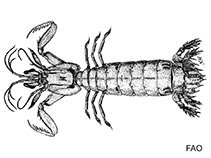Manningia notialis Manning, 1966
| Native range | All suitable habitat | Point map | Year 2050 |

|
| This map was computer-generated and has not yet been reviewed. |
| Manningia notialis AquaMaps Data sources: GBIF OBIS |
Upload your photos
Google image | No image available for this species;
drawing shows typical species in Eurysquillidae.
Google image | No image available for this species;
drawing shows typical species in Eurysquillidae.
Classification / Names Common names | Synonyms | CoL | ITIS | WoRMS
Malacostraca | Stomatopoda | Eurysquillidae
Environment: milieu / climate zone / depth range / distribution range Ecologia
; distribuzione batimetrica 0 - 10 m (Ref. 3099). Tropical
Distribuzione Stati | Aree FAO | Ecosystems | Presenze | Introduzioni
Western Central Pacific: Australia.
Length at first maturity / Size / Peso / Age
Maturity: Lm ? range ? - ? cm Max length : 6.9 cm TL maschio/sesso non determinato; (Ref. 3099)
Life cycle and mating behavior Maturità | Riproduzione | Deposizione | Uova | Fecundity | Larve
Some members of the order Stomatopoda pair for life and some come together only to mate. Males produce sperm ducts rather than spermatophores; females can brood a maximum of 50,000 eggs. Life cycle: Eggs hatch to a planktonic zoea which lasts for 3 months.
Main reference
Bibliografia | Coordinatore | Collaboratori
Ahyong, S.T. 2001. (Ref. 3099)
IUCN Red List Status (Ref. 130435: Version 2024-1)
CITES status (Ref. 108899)
Not Evaluated
CMS (Ref. 116361)
Not Evaluated
Threat to humans
Harmless
Human uses
| FishSource |
Strumenti
Informazioni ulteriori
Trophic Ecology
Prede
Dieta
Consumo di cibo
Razione
Predatori
Dieta
Consumo di cibo
Razione
Predatori
Ecology
Population dynamics
Accrescimento
Age/Size
Length-weight
Length-length
Length-frequencies
Mass conversion
Reclutamento
Abbondanza
Age/Size
Length-weight
Length-length
Length-frequencies
Mass conversion
Reclutamento
Abbondanza
Life cycle
Distribution
Human Related
Profilo di acquacoltura
Stamps, Coins Misc.
Stamps, Coins Misc.
Outreach
References
Fonti Internet
BHL | BOLD Systems | CISTI | DiscoverLife | FAO(Publication : search) | Fishipedia | GenBank (genome, nucleotide) | GloBI | Gomexsi | Google Books | Google Scholar | Google | PubMed | Tree of Life | Wikipedia (Go, ricerca) | Zoological Record
Estimates based on models
Preferred temperature
(Ref. 115969): 24.7 - 29.4, mean 28.1 (based on 1066 cells).



